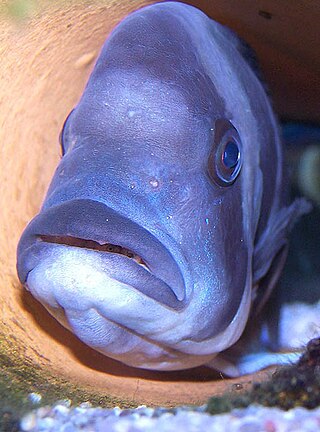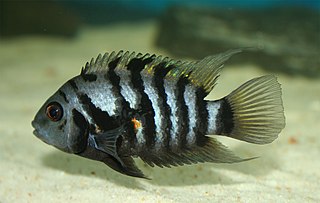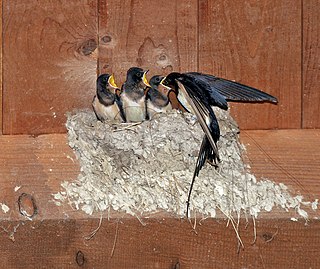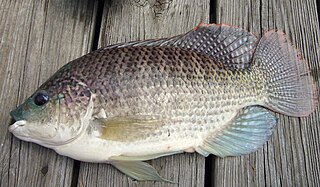
Cichlids are fish from the family Cichlidae in the order Cichliformes. Traditionally Cichlids were classed in a suborder, the Labroidei, along with the wrasses (Labridae), in the order Perciformes, but molecular studies have contradicted this grouping. On the basis of fossil evidence, it first appeared in Tanzania during the Eocene epoch, about 46–45 million years ago. The closest living relative of cichlids is probably the convict blenny, and both families are classified in the 5th edition of Fishes of the World as the two families in the Cichliformes, part of the subseries Ovalentaria. This family is large, diverse, and widely dispersed. At least 1,650 species have been scientifically described, making it one of the largest vertebrate families. New species are discovered annually, and many species remain undescribed. The actual number of species is therefore unknown, with estimates varying between 2,000 and 3,000.

Tilapia is the common name for nearly a hundred species of cichlid fish from the coelotilapine, coptodonine, heterotilapine, oreochromine, pelmatolapiine, and tilapiine tribes, with the economically most important species placed in the Coptodonini and Oreochromini. Tilapia are mainly freshwater fish inhabiting shallow streams, ponds, rivers, and lakes, and less commonly found living in brackish water. Historically, they have been of major importance in artisanal fishing in Africa, and they are of increasing importance in aquaculture and aquaponics. Tilapia can become a problematic invasive species in new warm-water habitats such as Australia, whether deliberately or accidentally introduced, but generally not in temperate climates due to their inability to survive in cold water.

Mouthbrooding, also known as oral incubation and buccal incubation, is the care given by some groups of animals to their offspring by holding them in the mouth of the parent for extended periods of time. Although mouthbrooding is performed by a variety of different animals, such as the Darwin's frog, fish are by far the most diverse mouthbrooders. Mouthbrooding has evolved independently in several different families of fish.

The convict cichlid is a fish species from the family Cichlidae, native to Central America, also known as the zebra cichlid. Convict cichlids are popular aquarium fish and have also been the subject of numerous studies on fish behaviour.
The Wami tilapia is a tilapiine cichlid that grows to over 20 cm in length and is considered a useful food fish in Tanzania and the island of Zanzibar, where it may have been introduced by man. It is tolerant of brackish water and grows well in saline pools, making it particularly suitable for aquaculture by communities living close to the sea. Like other tilapia it is an omnivore and will feed on algae, plants, small invertebrates, and detritus. The common name refers to the Wami River.

In biology, a pair bond is the strong affinity that develops in some species between a mating pair, often leading to the production and rearing of young and potentially a lifelong bond. Pair-bonding is a term coined in the 1940s that is frequently used in sociobiology and evolutionary biology circles. The term often implies either a lifelong socially monogamous relationship or a stage of mating interaction in socially monogamous species. It is sometimes used in reference to human relationships.

The Nile tilapia is a species of tilapia, a cichlid fish native to parts of Africa and the Levant, particularly Israel and Lebanon. Numerous introduced populations exist outside its natural range. It is also commercially known as mango fish, nilotica, or boulti.

Sarotherodon is a genus of oreochromine cichlids that are native to the northern half of Africa, with a single species, S. galilaeus, also ranging into the Levant. A couple of species from this genus have been introduced far outside their native range, and are important in aquaculture. Most other species have small ranges and some are seriously threatened. They mainly inhabit fresh and brackish water, but a few can live in salt water. Species in this genus, as well as those in several other oreochromine and tilapiine genera, share the common name "tilapia" and historically they were included in the genus Tilapia.

Pelvicachromis pulcher is a freshwater fish of the cichlid family, endemic to Nigeria and Cameroon. It is popular amongst aquarium hobbyists, and is most commonly sold under the name kribensis, although it has other common names, including various derivatives and color morphs of the kribensis: krib, common krib, red krib, super-red krib and rainbow krib, along with rainbow cichlid and purple cichlid.

The Texas cichlid, also known as the Rio Grande cichlid, is a freshwater fish of the cichlid family, and the only cichlid species that is native to the United States. It is found in the lower Rio Grande drainage in Texas near Brownsville and northeastern Mexico.

The Tilapiini are a tribe within the family Cichlidae commonly known as tilapiine cichlids. Formerly this tribe contained many other genera and species, including the economically important Oreochromis and Sarotherodon, but a taxonomic review found that this grouping was paraphyletic and most were moved to Coelotilapini, Coptodonini, Heterotilapini, Oreochromini and Pelmatolapiini. Together, most species in these tribes are called "tilapias". In a more distant past, a number of other, more different genera like Steatocranus also were included in Tilapiini. With these as separate, Tilapiini now is a much more restricted tribe with only three genera and about half a dozen species from Central and Southern Africa.

The Mozambique tilapia is an oreochromine cichlid fish native to southeastern Africa. Dull colored, the Mozambique tilapia often lives up to a decade in its native habitats. It is a popular fish for aquaculture. Due to human introductions, it is now found in many tropical and subtropical habitats around the globe, where it can become an invasive species because of its robust nature. These same features make it a good species for aquaculture because it readily adapts to new situations. It is known as black tilapia in Colombia and as blue kurper in South Africa.

The scissortail sergeant or striptailed damselfish is a large damselfish. It earns its name from the black-striped tail and sides, which are reminiscent of the insignia of a military Sergeant, being similar to those of the sergeant major damselfish. It grows to a length of about 16 centimetres (6.3 in).

Parental care is a behavioural and evolutionary strategy adopted by some animals, involving a parental investment being made to the evolutionary fitness of offspring. Patterns of parental care are widespread and highly diverse across the animal kingdom. There is great variation in different animal groups in terms of how parents care for offspring, and the amount of resources invested by parents. For example, there may be considerable variation in the amount of care invested by each sex, where females may invest more in some species, males invest more in others, or investment may be shared equally. Numerous hypotheses have been proposed to describe this variation and patterns in parental care that exist between the sexes, as well as among species.
Mate desertion occurs when one or both parents abandon their current offspring, and thereby reduce or stop providing parental care. Often, by deserting, a parent attempts to increase breeding opportunities by seeking out another mate. This form of mating strategy behavior is exhibited in insects, birds and mammals. Typically, males are more likely to desert, but both males and females have been observed to practice mate desertion.

The blue tilapia is a species of tilapia, a fish in the family Cichlidae. Native to Northern and Western Africa, and the Middle East, through introductions it is now also established elsewhere, including parts of the United States, where it has been declared an invasive species and has caused significant environmental damage. It is known as the blue kurper in South Africa.
Polyandry in fishes is a mating system where females mate with multiple males within one mating season. This type of mating exists in a variety of animal species. Polyandry has been found in both oviparous and viviparous bony fishes and sharks. General examples of polyandry occur in fish species, such as green swordtails and Trinidadian guppies. Specific types of polyandry have also been classified, such as classical polyandry in pipefish cooperative polyandry in cichlids and convenience polyandry in sharks.

The blackchin tilapia is a species of cichlid native to coastal west Africa. It is a paternal mouthbrooder which has been introduced to Asia and North America.

The redbelly tilapia, also known as the Zille's redbreast tilapia or St. Peter's fish, is a species of fish in the cichlid family. This fish is found widely in fresh and brackish waters in the northern half of Africa and the Middle East. Elsewhere in Africa, Asia, Australia and North America, it has been introduced as a food fish or as a control of aquatic vegetation. Where introduced, it sometimes becomes invasive, threatening the local ecology and species. The redbelly tilapia is an important food fish and sometimes aquacultured.

Oreochromini is a tribe of cichlids in the Pseudocrenilabrinae subfamily that is native to Africa and Western Asia, but a few species have been widely introduced to other parts of the world. It was formerly considered to be part of the tribe Tilapiini but more recent workers have found that the Tilapiini sensu lato is paraphyletic. Despite this change, species in Oreochromini are still referred to by the common name tilapia and some of the most important tilapia in aquaculture —certain species of Oreochromis and Sarotherodon— are part of this tribe. In contrast, several species have small ranges and are seriously threatened; a few are already extinct or possibly extinct.

 in Chad [4]
in Chad [4]  in Burkina Faso, Côte d'Ivoire and Ghana [5]
in Burkina Faso, Côte d'Ivoire and Ghana [5] 
















